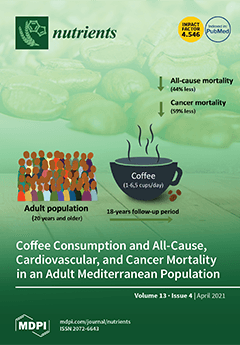The
exposome represents the array of dietary, lifestyle, and demographic factors to which an individual is exposed. Individual components of the exposome, or groups of components, are recognized as influencing many aspects of human physiology, including cardiometabolic health. However, the influence of the
[...] Read more.
The
exposome represents the array of dietary, lifestyle, and demographic factors to which an individual is exposed. Individual components of the exposome, or groups of components, are recognized as influencing many aspects of human physiology, including cardiometabolic health. However, the influence of the whole exposome on health outcomes is poorly understood and may differ substantially from the sum of its individual components. As such, studies of the complete exposome are more biologically representative than fragmented models based on subsets of factors. This study aimed to model the system of relationships underlying the way in which the diet, lifestyle, and demographic components of the overall exposome shapes the cardiometabolic risk profile. The current study included 36,496 US Veterans enrolled in the VA Million Veteran Program (MVP) who had complete assessments of their diet, lifestyle, demography, and markers of cardiometabolic health, including serum lipids, blood pressure, and glycemic control. The cohort was randomly divided into training and validation datasets. In the training dataset, we conducted two separate exploratory factor analyses (EFA) to identify common factors among exposures (diet, demographics, and physical activity) and laboratory measures (lipids, blood pressure, and glycemic control), respectively. In the validation dataset, we used multiple normal regression to examine the combined effects of exposure factors on the clinical factors representing cardiometabolic health. The mean ± SD age of participants was 62.4 ± 13.4 years for both the training and validation datasets. The EFA revealed 19 Exposure Common Factors and 5 Physiology Common Factors that explained the observed (measured) data. Multivariate regression in the validation dataset revealed the structure of associations between the Exposure Common Factors and the Physiology Common Factors. For example, we found that the factor for fruit consumption was inversely associated with the factor summarizing total cholesterol and low-density lipoprotein cholesterol (LDLC,
p = 0.008), and the latent construct describing light levels of physical activity was inversely associated with the blood pressure latent construct (
p < 0.0001). We also found that a factor summarizing that participants who frequently consume whole milk are less likely to frequently consume skim milk, was positively associated with the latent constructs representing total cholesterol and LDLC as well as systolic and diastolic blood pressure (
p = 0.0006 and <0.0001, respectively). Multiple multivariable-adjusted regression analyses of exposome factors allowed us to model the influence of the exposome as a whole. In this metadata-rich, prospective cohort of US Veterans, there was evidence of structural relationships between diet, lifestyle, and demographic exposures and subsequent markers of cardiometabolic health. This methodology could be applied to answer a variety of research questions about human health exposures that utilize electronic health record data and can accommodate continuous, ordinal, and binary data derived from questionnaires. Further work to explore the potential utility of including genetic risk scores and time-varying covariates is warranted.
Full article






